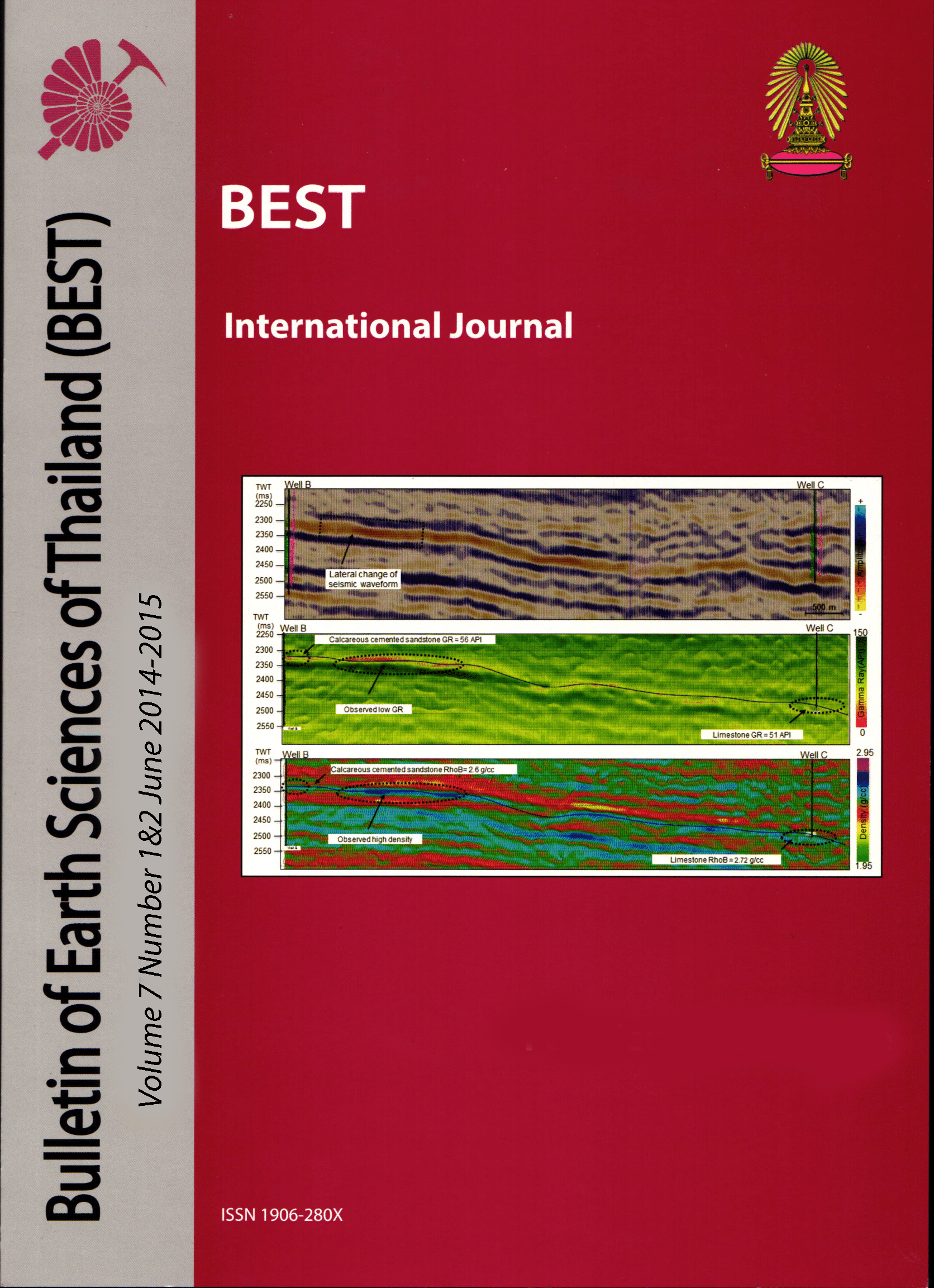Seismic Geomorphology of Fluvial Systems from Pleistocene to Recent in Southern Pattani Basin, Gulf of Thailand
Main Article Content
Abstract
The purpose of this study is to document the distribution and architecture of fluvial systems within the Pleistocene to Recent section in the southern margin of Pattani Basin, Gulf of Thailand, by integrating time slices and vertical seismic sections. The study interval is from 111 to 271 ms TWTT. Conventional seismic amplitude attribute maps show meaningful channel patterns for analysis. Key channel parameters were measured. Eustacy and climate fluctuations, which in turn affects sedimentation and fluvial discharge, are the most likely controlling factors in the development of fluvial systems in the study area. Moreover, the study interval represents the post-rift section; hence, tectonics has no significant effect on sedimentation. Unincised fluvial systems include low sinuosity (1.1-1.20), medium sinuosity (1.21-1.50), and high sinuosity channels (>1.50), with meander-belt widths ranging between 0.3 and 1.4 km, abandoned channel widths of 20 to 650 m, and channel depths of 4 to 19 m. These channels do not have tributaries associated with them. Incised valleys tend to be deeper (up to 50 meters) and wider systems (up to 1.3 kilometers). Tributaries provide the most significant evidence for the existence of incised valleys. Three depositional periods were identified based on fluvial styles. Period 1 (271-239 ms) begins with high to moderate sinuosity channels, and eventually shifts to low sinuosity channel, which indicates a depositional environment that is fluvial-dominated with estuarine influence in the upper part. The onset of Period 2 (239-191 ms) is marked by a sequence boundary, as evidenced by the presence of an incised valley. Low to moderate sinuosity channels dominate this period, which suggest low to modest accommodation generation, consistent with either slow transgression or highstand. The depositional environment of Period 2 is dominantly of estuarine influence. A second sequence boundary, that is marked by the presence of another incised valley, indicates the onset of Period 3 (191-111 ms). High to moderate sinuosity channels dominate the lower part and eventually shifts to low sinuosity channels in the upper part.
Article Details

This work is licensed under a Creative Commons Attribution-NonCommercial-NoDerivatives 4.0 International License.
Copyright © 2008 Department of Geology, Faculty of Science, Chulalongkorn University. Parts of an article can be photocopied or reproduced without prior written permission from the author(s), but due acknowledgments should be stated or cited accordingly.
References
Blum, M. D., 1993, Genesis and architecture of incised valley fill sequences: A Late Quaternary example from the Colorado River, Gulf Coastal plain of Texas, in Weimer, P., and Posamentier, H. W., eds., Siliciclastic Sequence Stratigraphy: Recent Developments and Applications: AAPG Memoir 58, p. 259–283.
Miall, A. D., 2002, Architecture and sequence stratigraphy of Pleistocene fluvial systems in the Malay Basin, based on seismic time-slice analysis: AAPG Bulletin, v. 86, p. 1201-1216.
Posamentier, H. W., and G. P. Allen, 1999, Silisiclastic sequence stratigraphy: Concepts and applications: SEPM Concepts in Sedimentology and Paleontology, v. 9, 210
Posamentier, H. W., 2001, Lowstand alluvial bypass systems: Incised vs. unincised: AAPG Bulletin, v. 85, p. 1771-1793.
Reijenstein, H. M., Posamentier, H. W., and Bhattacharya, J. P., 2011, Seismic geomorphology and high-resolution seismic stratigraphy of inner-shelf, fluvial, estuarine, deltaic, and marine sequences, Gulf of Thailand: AAPG Bulletin, v. 95, no. 11, p. 1959-1990.
Rosgen, D. L.,1994, A classification of natural rivers. CATENA, 22, 169-199.


